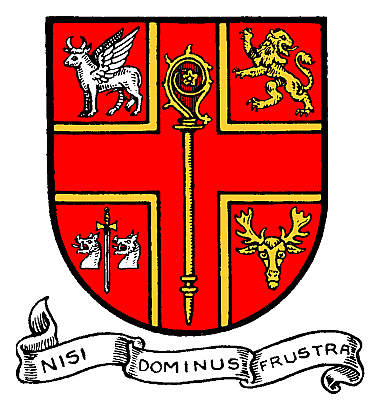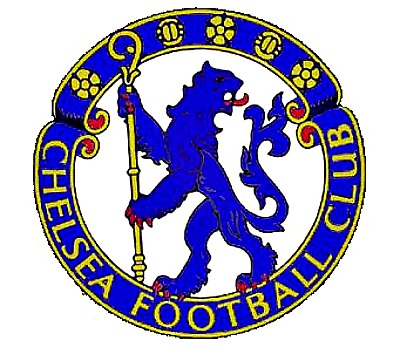One of the joys of working with colour is that it encompasses all aspects of life. Several of my projects take me into areas that I have little experience of and the one centred on the colours associated with the early years of Chelsea Football Club was certainly one of these. However, having considered the challenge and understood that it was a combination of research and a knowledge of colour nomenclature I was eager to pursue it.
Three early colours had been identified by the Club historian, Rick Glanvill. These were:
1) 1905 Cadogan blue (team shirt)
2) 1905 Metropolitan Borough of Chelsea Red (coat of arms)
3) 1907 Royal Blue (team shirt)
However, what exactly did these colours look like?
CADOGAN BLUE

It appears that Chelsea Football Club originally opted for the jersey colour Eton blue with white shorts and black socks with stripes around the top. The club’s first President was Earl Cadogan, an old Etonian, and he already used Eton blue as his horseracing colours.
According to Weatherbys Ltd, the company who provides British horse racing with its central administration, the racing colours of the 6th Earl Cadogan were Eton blue and have been registered to the family since at least the 1890s. As a result the unofficial name Cadogan Blue has been given to Earl Cadogan’s racing silks.
In the only work on the subject we are told that:
“The origins of the colour Eton Blue, are enshrouded in the depths of time. No one knows for sure whence it came. Probably before 1625, when Matthew Say, Eton College Waterman, was provided with “a coat of blew azure” as mentioned in the College accounts.”2
In the Dictionary of Colours for Interior Decoration the following notes are given under Cambridge Blue:
“This ‘Light Blue’ of the English University has from time to time caused some controversy. Cambridge Blue is supposed to be the same as Eton Blue, the latter dating from the fifteenth century, and being adopted by Cambridge in 1836.
The story goes that an old Etonian of the Cambridge crew in the boat race of 1836 supplied the distinguishing colour which was carried by the cox, and the colour was adopted as a permanent colour for the University Boat Club.
Probably some surprise will be occasioned by the colour here featured as Cambridge Blue (shown above), but it is matched to the coloured material supplied by the University outfitters and the Secretary of the Cambridge Boat Club, 1934, as supplied to and worn by rowing ‘Blues’.”
So it appears that Cadogan Blue, Eton Blue and Cambridge Blue were the same colour and that this was the colour of the Chelsea shirt until the 1907-08 season when Royal Blue was adopted.
THE METROPOLITAN BOROUGH OF CHELSEA RED

The borough was granted a coat of arms by the College of Arms on 28 February 1903. The blazon was:
Gules within a cross voided or a crozier in pale of the last in the first quarter a winged bull statant in the second a lion rampant reguardant both argent in the third a sword point downwards proper and hilt gold between two boars’ heads couped at the neck of the third and in the fourth a stag’s head cabossed of the second.3
The winged bull is the symbol of St Luke, patron saint of Chelsea (St Luke’s parish church is just off the King’s Road). The other emblems referred to various holders of the manor over the centuries: the crozier for Westminster Abbey, the lion for Earl Cadogan (first mayor of the borough), the boars’ heads and sword for the Sloane family and the stag’s head for the Stanley family.4
The motto was Nisi dominus frustra or “It is vain without the Lord”.
The fourfold division of the shield was a design favoured by Albert Woods, Garter King of Arms for municipal grants: other examples in London being the metropolitan boroughs of Bermondsey, Camberwell, Islington, Kensington, Southwark.
The blazon starts with the word Gules which is the heraldic term for red. Its position as the first word in the blazon indicates that it is the background colour of the shield.
One of the main aims of heraldry is to provide easily recognisable symbols and this is achieved by using bright clear colours and by following strict rules. From the earliest times Gules (red) has always been shown using the pigment vermilion.
In spite of the above there has always been a bit of lee-way in terms of colour and one will find slight variations. For further information one can once again turn to the work of the British Colour Council.
A publication produced by the in 1937 to celebrate the Coronation of King George VI – Traditional British Colours is useful. This volume displayed coloured silk ribbons to show such things as the colours of the Orders of Knighthood, those of the Armed Forces and Heraldic Colours. It also shows quite clearly the colours used in heraldry.
ROYAL BLUE

Rick Glanvill had discovered a reference to Chelsea wearing ‘Royal Blue’ in autumn 1907. However no jerseys from that period appear to have survived, nor are there any colour photographs. For technical reasons, in view of the different photographic processes of the early 1900s, one cannot read too much into the comparative depth of the dark blues seen in the black and white photographs.
One clue might be in the blue ink colour used for the club’s matchday programme, the Chelsea FC Chronicle, over many years. This seems to suggest the sort of colour seen in the Dictionary of Colours for Interior Decoration and labelled ‘Royal Blue’ (shown above). It is described as follows:
“A colour name originally used for smalt5 but later used in the textile and allied trades for the colour here shown which was standardised by BCC in 1934.”
It must be understood that colours will appear quite different in different materials. Although certain colours can be produced as paint, for example, they will have a very different appearance in fabric, whether cotton, wool or 100% DriFIT pique polyester. It is for this reason that the colours shown in the Dictionary of Colours for Interior Decoration are displayed in three formats – matt, gloss and a pile fabric (like carpet). This point must be considered carefully in relation to the colours of football shirts.
NOTES
1 The design of this crest was inspired by the civic coat of arms of the Metropolitan Borough of Chelsea. The use of the lion on the crest came from the Arms of Earl Cadogan, president of the club who also held the title of Viscount Chelsea. The crozier in the paws of the lion is that of the Abbot of Westminster whose jurisdiction extended over Chelsea. Roses represent England and the footballs represent the game of soccer.
2 Robert Harbord. Searching for Style: The Old Etonian Colour. 2008. Mr Harbord is also an Old Etonian.
3 For more information on heraldry and the colours used see Heraldic Colours.
4 The blazon for the Cadogan arms is – Quarterly, 1st and 4th, gules a lion rampant regardant or; 2nd and 3rd argent three boars’ heads couped sable (or means gold; argent means silver and sable means black). The arms of the Sloane family are (translated) – Red a sword in pale, silver point downwards gold pommel, and hilt, two silver boars heads couped at the neck. It will be seen that boars’ heads are shared by the Cadogan and Sloane families. The arms of the Stanley family, Earls of Derby, are Argent, on a bend azure three buck’s heads cabossed or.
5 Something of this pigment can be learnt here
I am most grateful to Rick Glanvill and others at Chelsea Football Club for their help and support. I am also grateful to David Moor of Historical Football Kits, Bridgend for his comments. See his page on Chelsea kit.












No comments yet. Be the first!